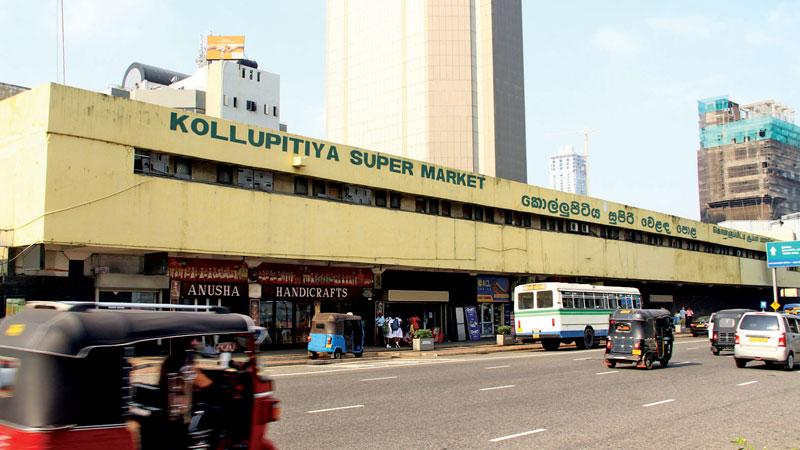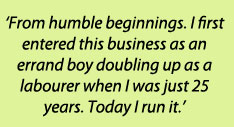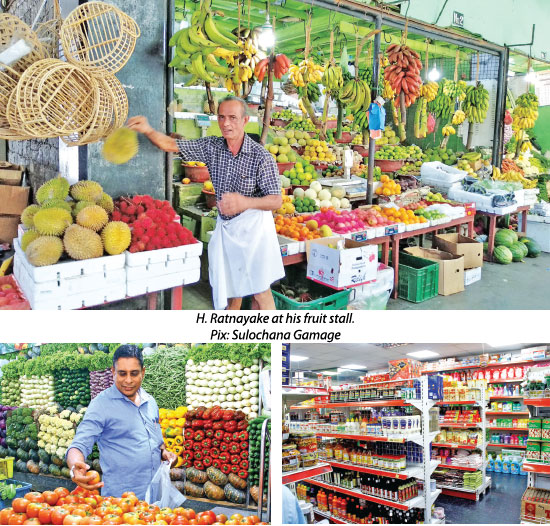
The Kollupitiya market is a historical landmark in the Colombo city. Established over a hundred years ago, the market which once sold fish has developed to a multi-faceted supplier of fresh vegetables, fruits, poultry, grocery items as well as rare and awesome food products from Australia and the UAE.
 11.30 a.m Sunday: The heat is already at its zenith and as we enter the Kollupitiya market the cool rush of wind from the open spaces inside is like an escape valve from the sweltering noonday sun outside. Standing to welcome us in his stall is H. Ratnayake. Hair combed neatly to the side, at 71 years, he looks at least 10 years younger, the secret ingredient being in his words, “Being a good Buddhist, I bear malice to none and have learned to cultivate inner peace.”
11.30 a.m Sunday: The heat is already at its zenith and as we enter the Kollupitiya market the cool rush of wind from the open spaces inside is like an escape valve from the sweltering noonday sun outside. Standing to welcome us in his stall is H. Ratnayake. Hair combed neatly to the side, at 71 years, he looks at least 10 years younger, the secret ingredient being in his words, “Being a good Buddhist, I bear malice to none and have learned to cultivate inner peace.”
The sound of constant traffic outside the market and raised voices of colleagues shouting out their fares, does not bother him. “My mind is only focused on my own stall, in which I spend my time no sooner the market opens. Inhaling the wholesome flavours and aroma of my fruits, and tasting them when I’m hungry, keeps me mentally and physically fit”.
It turns out that this self educated man is also more than just a fruit seller. Hearing that I wrote a health column for the Sunday Observer, he listed the benefits of eating colourful fruit and vegetables to boost the immune system. He picks up a bunch of red strawberries and yellow cauliflowers, kivi fruits, some green and red bell peppers which he has wedged in between his fruits, and tells me, “Citrus fruits and vegetables like these have high vitamin C and can even fight diseases like cancer. They are high in nutrients and proteins.”
 Ratnayake tucks his shirt into his white sarong and walks us to the middle of his fruit stall. Standing at the second entrance to the Kollupitiya market, it carries a number in brass letters - Number 2. His stall is aflame with bright colours of costumes worn by his regular customers who hail from different nationalities. Our nostrils twitch as we breathe in the aroma of ripe fruits that pack every inch of space in his small stall. Locally grown fruits mingle with their foreign counterparts. You can take your pick from guavas, durian, mangoes, bananas, papaya, lemon, locally grown oranges just plucked off the trees, he insists. Or if you want something exotic but imported you can choose from the dark purple and green grapes, red and yellow oranges, kiwi fruits, pineapples from the Philippines, strawberries, avocado pears from India.
Ratnayake tucks his shirt into his white sarong and walks us to the middle of his fruit stall. Standing at the second entrance to the Kollupitiya market, it carries a number in brass letters - Number 2. His stall is aflame with bright colours of costumes worn by his regular customers who hail from different nationalities. Our nostrils twitch as we breathe in the aroma of ripe fruits that pack every inch of space in his small stall. Locally grown fruits mingle with their foreign counterparts. You can take your pick from guavas, durian, mangoes, bananas, papaya, lemon, locally grown oranges just plucked off the trees, he insists. Or if you want something exotic but imported you can choose from the dark purple and green grapes, red and yellow oranges, kiwi fruits, pineapples from the Philippines, strawberries, avocado pears from India.
So how did it begin? I ask.
“From humble beginnings. I first entered this business as an errand boy doubling up as a labourer when I was just 25 years. Today I run it,” he says with a touch of justified pride.
Flashback to over 40 years and he says the number of shops in the market have not expanded.
“There were 12 shops then as far as I recall and there still are 12 shops on this floor (first floor), all selling a variety of edible products mostly fruits, vegetables, herbs .On the other side of this same floor is the meat and chicken market. On the upper floor you get the fish market and pork stalls.”
More customers
What about the customers? Have the numbers increased?
“Oh yes. At first I had just a handful of customers mostly locals. Today, as you see there are so many I can hardly cope with,” he says as he serves a woman from Indonesia. “Ganthi’s husband works at the Indonesian embassy here so she has been here for some time and has even picked up a smattering of the Sinhala language. “I come here because I can get everything I want under one roof – from fruits, vegetables, spices to poultry,” she says. I watch while Siriwardana cuts her a tender slice of durian to taste. “Ï love durian and so does my family. It’s like chicken. We like the smell as well, as it is supposed to have healing qualities. You should try it”, she says as she sees me wince.
His colleague Wimalasiri has been in the same business for 50 years he says. He hitches his sarong to his waist, ties his hair into a knot, and wipes the sweat from his face as we ask him if we can talk to him. No, he says. He is much too busy to talk or even pose for a photo. He merely responds to my questions with a nod, serving his customers, mostly Chinese. Wuang, is served with a sliced mango, which is given free by Wimalasiri who is a shrewd businessman.
Chinese customers
He is from a group of Chinese visitors from the North territory and this is his first experience leaving his homeland. Speaking through one of the helpers at the fruit stall, Rajan who has learned to speak Chinese and also mastered some Bengali and Indian words, he says he and his colleagues have fallen in love with the country, its people, their smiles, beautiful beaches and the many colourful exotic fruits. He eats his mango without peeling the skin. His wife Chang wants the green skin peeled. She eats it with a small plastic spoon which Wimalasiri keeps for his special guests.
We next wander to the butchery on the same floor and talk to young Rifka who works for his father.”We have been butchers for generations and worked in this market after shifting from Narahenptiya. Our clientele consists of locals as well as foreigners. For the past two years we have seen many Chinese workers coming here for different cuts of meat. They like chicken legs and different parts of the chicken like gizzard, liver, neck, breast, wings. They use almost every part of the chicken and also beef to make soups. Rifka says he is planning to write a list of the parts available in Chinese and hang it on a board outside the shop. “The list is being printed with pictures as most of my customers don’t know a word of English or Sinhala. I will put it up once they return from their visit to China for the Chinese New Year.”
At Mohamad Najeeb’s miscellany shop on the same floor, his cosmetics, perfumes and fancy slippers are the least in demand among his best clientele - Chinese construction workers. “ What they want is cheap rubber slippers to replace the ones that have worn out,” he says.
Chaminda - another stall holder on the ground floor of the Kollupitiya market has been working at his fruit stall for the past 17 years. He agrees with his colleagues Siriwardene and Wimalasiri that the market has not changed physically since it was set up.
“However, our customers have increased dramatically with both local and foreign, mostly Chinese, Indians and Thai workers patronising it”, he says.
Unique market
We stop at a small Chinese shop ‘Yaling’ next to the butcher’s. Inside its cramped space is a treasure trove of Chinese delicacies, ranging from sauces, oils, flavours and spices brought down especially from China. It saves me the trouble of having to go all the way hunting for them as I can’t find these items in a supermarket”, a Thai lady tells me.
This unique market may still be lacking in modern technology. The ancient iron gates with large padlocks and chains have stood the test of time. Most importantly, stall holders and customers alike had only bouquets to offer this ancient icon which is 100 years since its inception.
